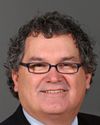Thank you.
Good afternoon. My name is Colleen Dane, and I'm the communications manager with the B.C. Salmon Farmers Association, based here in Campbell River.
I know that you've already had in-depth presentations from some of our member companies, government regulators, and national aquaculture representatives during your hearings in Ottawa, so I thought that since you are here in the west coast home of the industry, I would talk a little bit about what salmon farming brings to British Columbians.
You've likely heard the number 6,000 when it comes to employment, direct and indirect, by the industry. Here in the north island, salmon farming is the area's largest private employer. With 2,800 direct jobs, we are providing steady, year-round employment in communities that have been hard hit by the downturn in other resource economies. Mayors of towns like Port Hardy, Port McNeill, and Campbell River here openly recognize that these jobs are key in their communities.
The B.C. Salmon Farmers Association represents five salmon producers and over 35 supply and service companies. Along with growing salmon, our members produce the feed, process the harvest, provide the packaging, transport supplies, and build the facilities. Around 3,000 companies, though, provide services and supplies to the industry. Nearly 400 of those are considered large suppliers, working with three or more of our member companies. It's a close, collaborative and innovative community and one that is really a pleasure to be a part of.
It's quite the ripple effect, too, that salmon farming is creating. Cluster developments like these are considered healthy effective strategies for rural diversification. It's strengthening best practices, building concentrations of expertise, deepening labour pools, and strengthening regional growth. Each related activity spurs on more economic strength, so that everything from non-profit organizations to scientists to specialty product suppliers can succeed.
B.C.'s farmed salmon is B.C.'s largest agricultural export. The 2008 wholesale value of the year's harvest was $495.2 million. Federally, it's second only to east coast lobster for our seafood export values. Exports of nearly 50,000 tonnes were estimated to be worth $330.9 million in 2009.
It's a successful product, though, because it's a good product. B.C.'s farmed salmon is a valuable source of important nutrients and is a healthy protein that's consistent, reliable and fresh. We have the lowest level of antibiotic use of any livestock and the most efficient feed conversion rates. Our fish are well cared for and very healthy and our farms are excellently managed.
All of this is being done under the most stringent regulatory environment in the world for aquaculture. While the upcoming regulatory transfer to the federal government means change, we only expect that high standard to remain and in fact increase as we work together to achieve the most sustainable industry possible.
We know that it's important to reach the highest standards. We recognize that public attention has helped to create this industry in making it as strong and accountable as it is today. As technology advances and the business environmental settings continue to adapt, so will we. For example, our technical committee at the association brings together staff from each company to improve things like biosecurity and fish health management plans, and we are actively engaged as a group at the Cohen commission that has opened in Vancouver.
The goal of the B.C. Salmon Farmers Association is to continue educating the public about all that we've done and continue to do. Our extensive public outreach, with programs like our public tours, which run every summer, and our regular food shows, has shown us that while people may have questions about the industry, the feeling of a vast opposition is really very localized. More and more, people are talking about the reality of global food security, sustainable energy supplies, and protection of freshwater resources, and in all of those lights, our ocean-powered net pen farms are a bright example of how we can feed people into the future.
The United Nations Food and Agriculture Organization has said that 75% of the world's wild capture fisheries are at or near their maximum harvest rate. Yet by 2030, demand for fish is estimated to increase by 70%. Aquaculture is the way of the future. We believe that B.C. has a great opportunity to be a part of that worldwide solution. Places like Port Hardy and Campbell River here are helping to lead the way, so we appreciate you guys coming to meet us and talk today.


